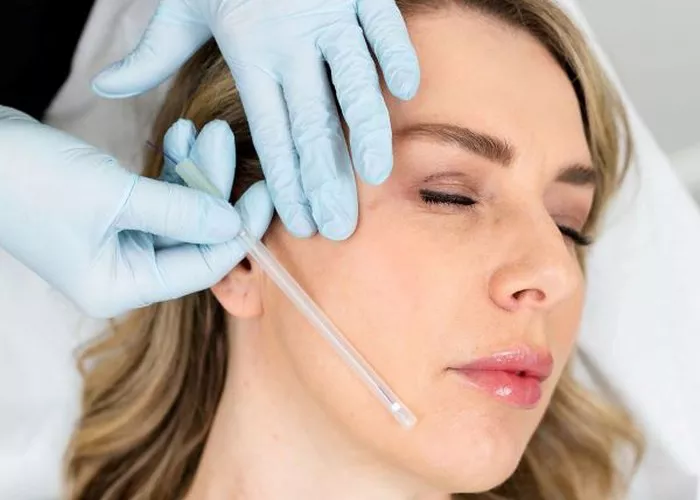Thread lifts have gained popularity as a non-surgical cosmetic procedure that offers a lifting and rejuvenating effect to the face and neck. While many individuals are intrigued by the potential benefits, concerns about pain and discomfort often arise. Are thread lifts painful? In this article, we will delve into the topic of thread lift pain, debunk common misconceptions, and provide insights into what to expect during the procedure.
Understanding Thread Lifts
A thread lift is a minimally invasive cosmetic procedure that aims to lift sagging skin and restore facial contours using dissolvable sutures or threads. These threads are inserted into the skin to lift and reposition the tissues, resulting in a more youthful and lifted appearance. The procedure is known for its ability to address mild to moderate signs of aging, such as sagging skin, fine lines, and loss of facial volume.
The Role of Anesthesia
One of the primary concerns individuals have regarding thread lifts is the pain associated with the procedure. It is important to note that thread lifts are typically performed under local anesthesia. Local anesthesia numbs the treatment area, ensuring that you remain comfortable throughout the procedure. The anesthesia is administered via injections, which may cause a slight discomfort similar to a pinch or stinging sensation. However, the discomfort is usually temporary and well-tolerated by most individuals.
Minimizing Discomfort during the Procedure
To further minimize any potential discomfort during the thread lift procedure, the following techniques may be employed:
1. Topical Anesthesia: Before administering local anesthesia, a topical numbing cream or gel may be applied to the treatment area. This helps to numb the skin and reduce the sensation of the initial needle pricks.
2. Gentle Techniques: Skilled and experienced practitioners utilize gentle techniques during the thread lift procedure to minimize discomfort. They carefully insert the threads into the desired areas, ensuring a smooth and precise process.
3. Patient Comfort: Practitioners prioritize patient comfort and well-being during the procedure. They communicate with you, explaining each step of the process and addressing any concerns or questions you may have. This helps to create a calm and relaxed environment, enhancing the overall experience.
Post-Procedure Sensations
After the thread lift procedure, it is common to experience some mild sensations or discomfort. These sensations may include:
1. Soreness: The treatment area may feel slightly sore or tender for a few days following the procedure. This is typically manageable with over-the-counter pain relievers, as recommended by your practitioner.
2. Bruising and Swelling: Some individuals may experience mild bruising and swelling around the treatment area. These effects are usually temporary and subside within a few days to a week.
3. Tightness or Pulling Sensation: You may experience a mild sensation of tightness or a pulling effect as the threads settle and begin to lift the skin. This is a normal part of the healing process and should diminish over time.
It is important to note that these post-procedure sensations are typically mild and transient. Most individuals find them to be well-tolerated and manageable with appropriate aftercare and pain management techniques.
Recovery and Aftercare
Following a thread lift procedure, your practitioner will provide you with specific aftercare instructions to ensure a smooth and comfortable recovery. These instructions may include:
1. Limiting Physical Activity: It is advisable to avoid strenuous activities, heavy lifting, and intense facial expressions for a few days following the procedure. This helps to minimize the risk of discomfort and allows the threads to settle properly.
2. Gentle Skincare: Practitioners typically recommend gentle skincare routines during the initial healing phase. Avoid aggressive facial treatments, excessive rubbing or massaging of the treatment area, and exposure to harsh chemicals or extreme temperatures.
3. Pain Management: Over-the-counter pain relievers, such as acetaminophen or ibuprofen, can be used to manage any mild discomfort or soreness. However, always consult with your practitioner before taking any medications.
4. Follow-Up Appointments: Your practitioner may schedule follow-up appointments to assess your progress, address any concerns, and ensure optimal healing. These appointments are an opportunity to discuss any discomfort or sensations you may be experiencing.
Every Individual’s Experience is Unique
It is important to remember that every individual’s experience with a thread lift procedure is unique. Factors such as individual pain tolerance, the extent of the treatment, and the specific technique used can influence the level of discomfort. Communicating openly with your practitioner about your concerns and expectations can help ensure a comfortable and positive experience.
Choosing an Experienced Practitioner
Selecting an experienced and skilled practitioner is crucial for a successful and comfortable thread lift procedure. Look for a board-certified professional with a proven track record in performing thread lifts. Research their credentials, read reviews, and schedule a consultation to discuss the procedure in detail. A qualified practitioner will prioritize your comfort, explain the procedure thoroughly, and address any questions or concerns you may have.
The Benefits Outweigh the Discomfort
While the idea of discomfort during a thread lift procedure may seem daunting, it is important to recognize that the potential benefits can outweigh the temporary sensations. Thread lifts offer a minimally invasive alternative to surgical facelifts, providing a natural-looking lift and rejuvenation. The results can last for months to a year or more, depending on various factors such as individual physiology and lifestyle.
Conclusion
Thread lifts are generally well-tolerated and cause minimal discomfort when performed by skilled professionals. With the use of local anesthesia and gentle techniques, any potential pain during the procedure is typically managed effectively. The mild post-procedure sensations experienced are transient and can be managed with proper aftercare and pain management techniques. By choosing a qualified practitioner and openly communicating your concerns, you can undergo a thread lift procedure with confidence, knowing that any discomfort will be minimal and temporary, and the benefits will enhance your appearance and confidence.


